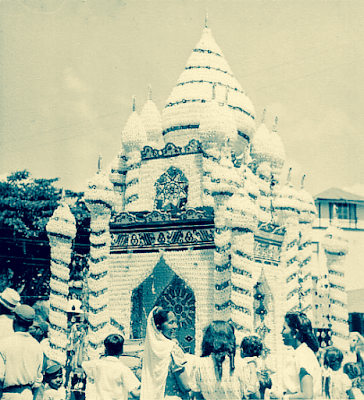 |
| Photo: The Golden Thread Gallery |
JEAN-ULRICK Désert is familiar with Leviticus. He used that Biblical book as the title of a series of works on paper in 2008. For a new piece shown as part of Caribbean Queer Visualities in November, Désert returns to the Bible, this time referencing Matthew 7:6, with its edict, “do not cast pearls before swine.”
Désert fills a room with pearlescent balloons and hangs rainbow-coloured garlands that replicate the edict in different languages, including patois. The atmosphere is celebratory, yet ambivalent. There are also chains dangling from the ceiling. We look up to the roof at the seminal balloons, adjusting our body as we enter the room.
“The Bible is used as a strategy against the LGBTI community,” the artist says as we chat over dinner in Belfast where the show was staged. “I am reacting to that strategy and acknowledging that for those of us who speak this patois there is an intimacy that we share when we communicate in it.”
The artist continues, “It’s private, it is familial, which gives it a certain power and place of privilege. To me that seems an appropriate strategy for an intimate topic such as desire.”
This polyvalence is fitting for the subject matter, especially in context of Caribbean societies that have driven questions of sexuality underground into the realm of subterfuge and shadow play. Désert’s piece reflects a precarious tight-rope act. On the one hand it is festive, on the other hand it stands in awe – maybe fear – of desire. The use of “swine” in the title connotes various forms of kink, in addition to its figurative meaning.
“As we know, the figure of the pig is also someone who engages in something excessive,” Désert says. “There is also a certain obstinacy that comes with being a pig. When someone is called a pig it infers a variety of things.” If the message is lost, then this demonstrates how sacred texts are inherently malleable. They therefore serve as poor justifications for bigotry.
It Neque mittatis margaritas Vestras ante porcos (Do Not Cast Pearls Before Swine) is a serious warning from an artist who knows all too well the price of intolerance.
As a child, Désert’s family fled his native Haiti when it was under the grip of the first Duvalier regime.
“We were thrown into exile,” Désert says. “We lived in the Brazilian Embassy for a number of months until the President’s birthday when we were able to escape for the airport, making our way from Haiti to New York. One more day, all three of us would have been murdered.”
LOVE, ANGER, MADNESS
Désert continues, “My mother is still very reticent to talk about it. This is from what I pieced together from my father. Their marriage would eventually suffer and fall apart by the time we were living in the States. Even when my mom got divorced and she returned she was immediately arrested and stopped at an airport because we were still on a blacklist. Relatives had their businesses compromised. We had to abandon all our properties leaving me no physical legacy.” He adds, “but the cultural legacy cannot be erased.”
Désert has since lived in New York, Paris and now Berlin. He has earned degrees at Cooper Union and Columbia University and has lectured and been invited as a critic at Princeton, Yale, Humboldt. His work is impossible to pin down, including billboards, actions, paintings, site-specific sculptures, video and objects. A simple video of him standing at Piazza San Marco, Venice, during a flood tide takes on the air of something weighty and profound: commenting on history and fate.
In 2013’s Amour Colere Folie (Love Anger Madness), Désert pays homage to the Haitian author Marie Chauvet whose writing sent her into exile in New York until her death. Her work was later clandestinely published in 2002 reestablishing her once censored voice against the wishes of her family feared reprisals.
Désert pieces are united by this concern with the clandestine, not as willful obscurity, but as necessity. This is so whether he is working with burquas and flags, the exposed male body and lederhosen, or elaborately presented testimonials of sex workers. He hides things in plain sight, where they will be safest.
Or most dangerous, such as in La Main (The Hand) where that body part is cast in white chocolate, in a reference to the disturbing racist elements of Belgium’s history, a history which is not as well known as the country’s fine pralines.
“In my work in general I try not to impose my own personal point of view,” Désert says. “I would imagine one could say this about most of the practioners in this exhibit – we are not dedicated explicitly to a queer practice. It is implicitly there, they are one of many elements in our works.”
A tall, striking punk figure who combines dapper waistcoats with kilts, Désert adds, “I am very conscious of the male drag that I wear. Yet, that’s only one of about 50 layers of who I am. I don’t want to dis-empower the viewer to bring their own experiences in experiencing work. It’s poetic if one does it correctly.”
- from Sunday Newsday, December 18, page 3
*
Caribbean Queer Visualities was the outcome of a series of roundtable discussions by Small Axe and was staged at the Golden Thread Gallery as part of the Outburst Queer Arts Fest at Belfast last month.
Caribbean Queer Visualities was the outcome of a series of roundtable discussions by Small Axe and was staged at the Golden Thread Gallery as part of the Outburst Queer Arts Fest at Belfast last month.




















































